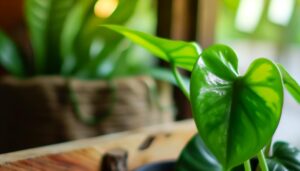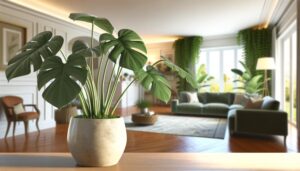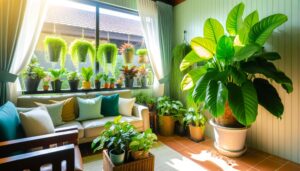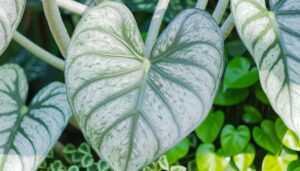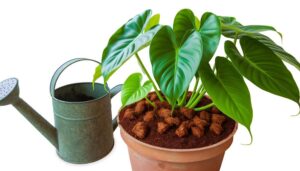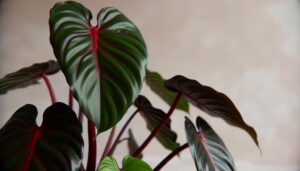What Is the Meaning of Philodendron Birkin?
Philodendron Birkin is a unique cultivar from the Philodendron genus, emerging due to a genetic mutation in Philodendron Rojo Congo. Belonging to the Araceae family, it is recognized for its distinctive variegated foliage, where irregular pigmentation patterns result from disrupted chlorophyll synthesis.
Philodendron Birkin thrives in bright, indirect sunlight and requires well-draining soil and balanced moisture levels. Its variegation can fluctuate based on environmental factors, making it a compelling plant for enthusiasts.
The plant's compact size and low maintenance elevate its popularity, while appropriate care guarantees vibrant foliage. To explore the nuances of its care and cultivation, proceed further.
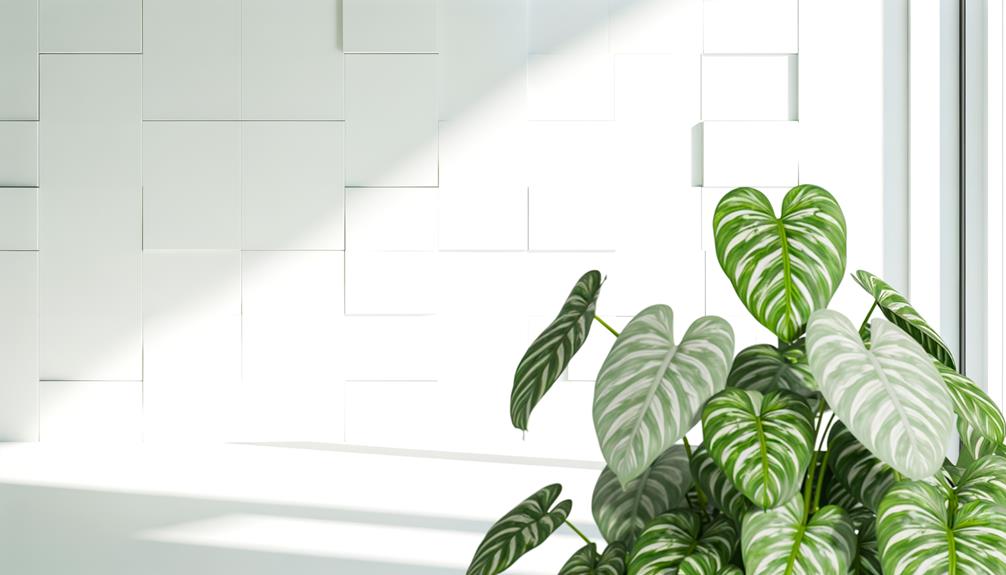
Key Takeaways
- Philodendron Birkin is a cultivar of the Philodendron genus, stemming from a genetic mutation in Philodendron Rojo Congo.
- The plant is renowned for its unique variegated foliage with white streaks due to disrupted chlorophyll synthesis.
- It belongs to the Araceae family and is native to tropical America, exhibiting a climbing growth habit.
- Philodendron Birkin thrives in bright, indirect light and requires consistent moisture levels with well-draining soil.
- Popular for its aesthetic appeal and low maintenance, it has become a favorite among indoor plant enthusiasts.
Origins of Philodendron Birkin
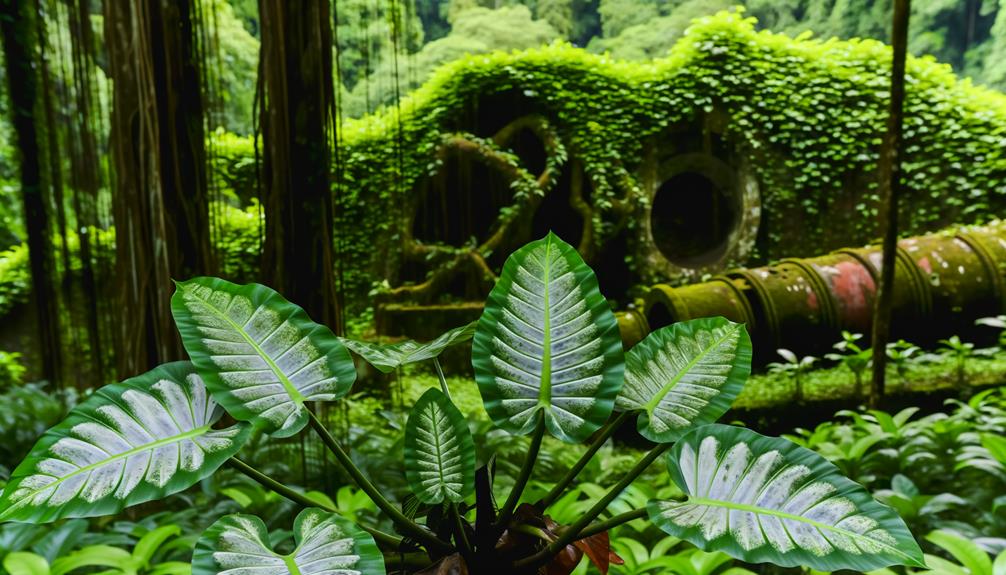
Although the exact origins of the Philodendron Birkin are somewhat ambiguous, it is widely accepted that this cultivar emerged from a spontaneous genetic mutation in the Philodendron Rojo Congo. This unexpected mutation resulted in distinctive variegation patterns characterized by its striking white to cream-colored pinstripes on dark green leaves. The variegation is due to altered chloroplast development, leading to sectors of the leaf lacking chlorophyll.
Genetic mutations such as these can occur naturally or be induced through tissue culture processes. The Philodendron Birkin gained rapid popularity among horticulturists and plant enthusiasts for its unique aesthetic appeal and manageable growth habit. Its relatively recent introduction to the market underscores the dynamic nature of plant breeding and cultivar development.
Botanical Classification
The Philodendron Birkin, belonging to the Araceae family, is classified within the Philodendron genus and is recognized for its unique variegated foliage.
This genus comprises approximately 489 species, making it one of the largest genera within the Araceae family. Philodendrons are primarily native to tropical America, thriving in humid, forested environments.
The Philodendron Birkin is a cultivar, indicating it is a product of selective breeding rather than a naturally occurring species. This plant exhibits characteristics typical of the genus, including aerial roots, heart-shaped leaves, and a climbing growth habit.
The Birkin's classification is grounded in its morphological traits, cellular structure, and genetic makeup, which align with the diagnostic features of the Philodendron genus and the broader Araceae family.
Unique Variegation

Characterized by its striking white and green striped foliage, the unique variegation of the Philodendron Birkin results from a genetic mutation that affects chlorophyll distribution in the leaves. This mutation disrupts the synthesis and localization of chlorophyll, creating irregular patterns of pigmentation.
The variegation varies among individual leaves, producing a spectrum of designs from bold white streaks to delicate green lines. This phenomenon, often termed chimera variegation, is a form of somatic mutation where different cell layers exhibit distinct genetic expressions.
The intricate patterns are not only aesthetically pleasing but also indicative of the plant's genetic instability. This variegation can fluctuate in intensity based on environmental factors such as light exposure and nutrient availability, adding to the plant's allure.
Care Requirements
The Philodendron Birkin requires specific environmental conditions to thrive, including ideal light and watering schedules, as well as carefully selected soil and fertilization routines.
This plant prefers bright, indirect sunlight and consistent moisture levels, avoiding both drought and waterlogging.
Additionally, a well-draining potting mix enriched with organic matter and periodic feeding with a balanced fertilizer is essential for sustained growth and vibrant variegation.
Light and Watering Needs
To achieve peak growth, Philodendron Birkin requires bright, indirect light and a consistent watering schedule that maintains evenly moist soil without causing waterlogging.
This plant thrives in environments where it receives filtered sunlight, which replicates its native tropical understory conditions. Excessive direct sunlight can lead to leaf burn, while insufficient light may stunt growth and diminish variegation.
Watering should be performed when the top inch of soil feels dry to the touch. Overwatering poses a significant risk, promoting root rot and fungal infections. Conversely, underwatering can cause leaf curling and browning at the edges. Utilizing a pot with drainage holes enhances water management, preventing excess moisture accumulation.
Monitoring environmental humidity also supports prime plant health.
Soil and Fertilizer
Philodendron Birkin's growth flourishes with a well-draining, nutrient-rich soil mix that combines organic matter with aerating components such as perlite or orchid bark. This specific blend ensures peak root health and prevents waterlogging, which can lead to root rot.
Regular fertilization during the growing season is vital to maintain its vibrant foliage.
To achieve ideal soil and fertilizer conditions, consider the following:
- Soil Composition: Use a blend of peat moss, perlite, and orchid bark to provide nutrients and aeration.
- pH Level: Maintain a slightly acidic to neutral pH (5.5-7.0) for optimal nutrient uptake.
- Fertilizer Type: Apply a balanced liquid fertilizer (20-20-20) every 4-6 weeks during the growing season.
- Organic Matter: Integrate compost or worm castings to enhance soil fertility and structure.
Popularity Surge
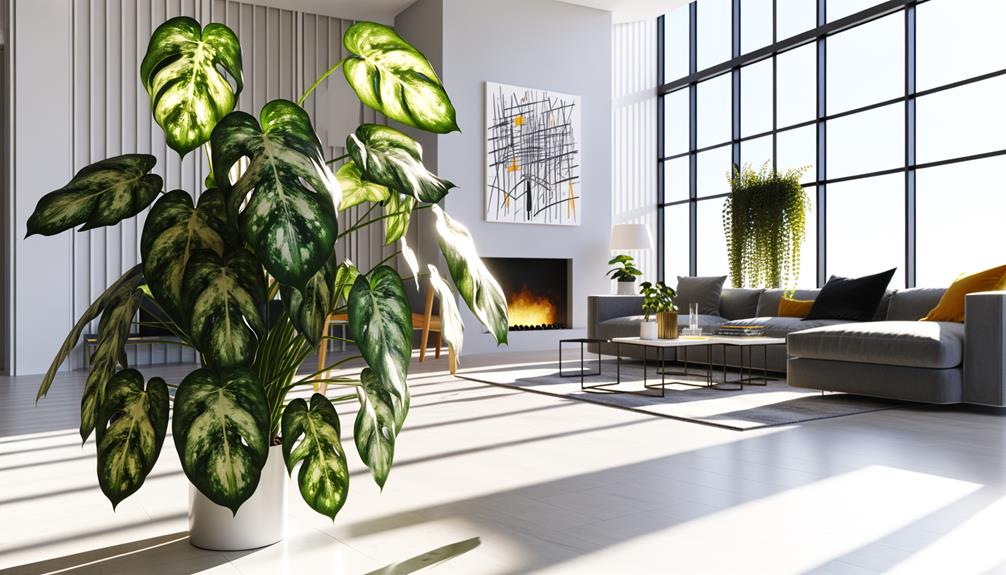
In recent years, a notable surge in popularity has been observed for the Philodendron Birkin, attributable to its unique variegated foliage and ease of cultivation.
The Philodendron Birkin features striking, cream-colored pinstripes on dark green, heart-shaped leaves, a mutation of the Philodendron Rojo Congo. These aesthetic characteristics, combined with the plant's low maintenance requirements, have made it a favorite among both novice and experienced horticulturists.
This species thrives in well-draining soil with moderate humidity and indirect light, making it adaptable to various indoor environments. Additionally, its relatively slow growth rate and compact size render it suitable for urban living spaces, further fueling its desirability.
Consequently, the Philodendron Birkin has become a prominent fixture in modern botanical collections.
Symbolism and Meaning
Beyond its aesthetic appeal and ease of care, the Philodendron Birkin carries rich symbolic significance, often associated with personal growth and transformation due to its dynamic variegation patterns. These unique characteristics can metaphorically represent various facets of human experience:
- Resilience: The plant's ability to thrive in diverse environments symbolizes the capacity to overcome challenges.
- Adaptability: Its changing leaf patterns reflect the importance of flexibility in maneuvering life's fluctuations.
- Renewal: The emergence of new variegated leaves signifies continuous self-improvement and renewal.
- Harmony: The balanced interplay of green and white hues embodies the equilibrium between different aspects of life.
This symbolism enriches the Philodendron Birkin's role in interior spaces, extending its value beyond mere decorative function.
Hybridization Process
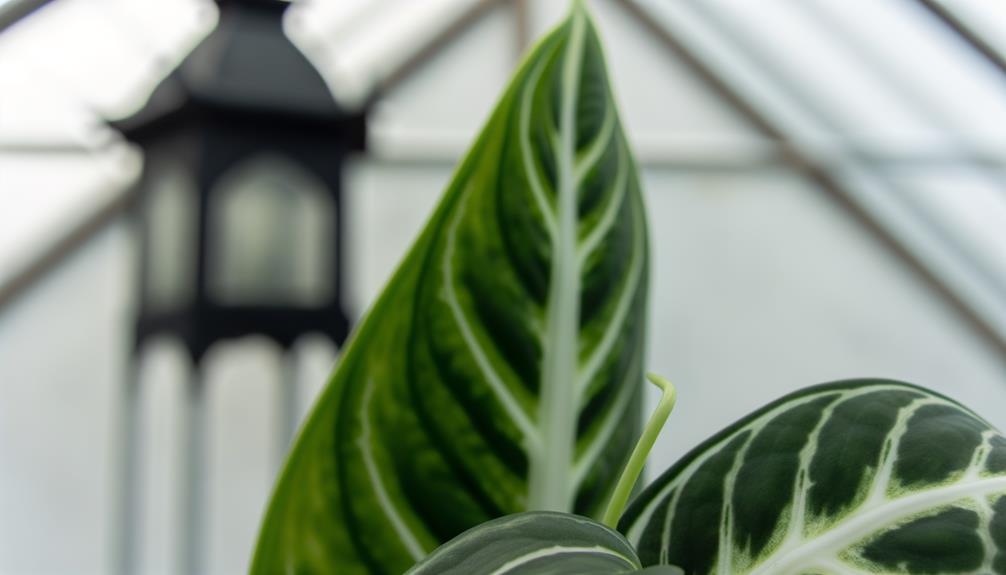
How does the complex process of hybridization contribute to the distinct characteristics of the Philodendron Birkin? The Philodendron Birkin is a result of meticulous hybridization, combining specific parent plants to achieve its signature variegation and compact growth habit. Hybridization involves controlled pollination, where desirable traits are selectively bred over multiple generations. This scientific process guarantees genetic diversity while stabilizing phenotypic attributes such as leaf coloration and morphology. The Birkin's striking white-striped leaves are a direct outcome of these carefully managed genetic manipulations.
| Parent Plant A | Parent Plant B | Resulting Trait |
|---|---|---|
| Philodendron 'Rojo Congo' | Philodendron 'Imperial Green' | Variegated Leaves |
| Philodendron 'Birkin' | Philodendron 'Erubescens' | Enhanced Growth Habit |
| Philodendron 'Moonlight' | Philodendron 'Prince of Orange' | Distinctive Leaf Morphology |
This rigorous hybridization process ultimately yields the aesthetically unique and resilient Philodendron Birkin.
Common Misconceptions
A common misconception surrounding the Philodendron Birkin is the belief that its variegation patterns will remain consistent under all environmental conditions. In reality, the variegation of this plant is highly susceptible to changes in light exposure, humidity, and nutrient availability.
Light Exposure: Insufficient light can cause the variegation to diminish, leading to mostly green leaves.
Humidity Levels: Low humidity can stress the plant, affecting its overall health and variegation.
Nutrient Availability: Inadequate or imbalanced fertilization may alter the expression of variegation.
Plant Age: Younger leaves may display different variegation patterns than mature leaves, contributing to the dynamic appearance of the plant.
Understanding these factors is essential for maintaining the Philodendron Birkin's aesthetic appeal.
Styling Tips
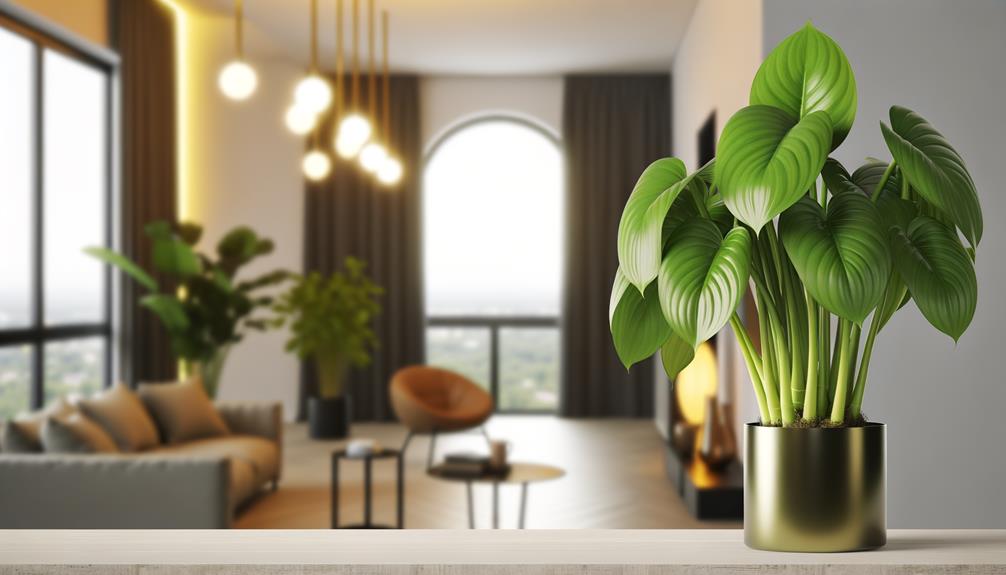
When styling a Philodendron Birkin, consider incorporating indirect light sources and consistent humidity to enhance its variegation and overall aesthetic appeal. Best light intensity is essential; positioning the plant near a north or east-facing window guarantees it receives adequate, diffused sunlight.
Additionally, maintaining ambient humidity levels between 60-70% will prevent leaf desiccation and promote lusher foliage. Utilize a hygrometer to monitor humidity accurately.
Soil composition should be well-draining yet moisture-retentive, incorporating perlite and peat moss for optimal aeration. Regularly rotate the plant to ensure even light distribution, thereby preventing phototropic growth.
Decorative planters that facilitate proper drainage can also complement the plant's striking white-striped leaves, creating a balanced and visually appealing indoor environment.
Troubleshooting Issues
While proper care and styling can greatly enhance the beauty of a Philodendron Birkin, it is equally important to identify and address common issues that may arise, such as leaf discoloration, pest infestations, and root rot. These problems can detract from the plant's aesthetic appeal and overall health.
- Leaf Discoloration: Often caused by incorrect light levels or nutrient deficiencies. Make sure the plant receives indirect sunlight and balanced fertilization.
- Pest Infestations: Common pests include spider mites and aphids. Regularly inspect foliage and use insecticidal soap or neem oil for treatment.
- Root Rot: Typically due to overwatering. Use well-draining soil and allow the top inch of soil to dry before watering.
- Slow Growth: May result from insufficient light or nutrient imbalance. Adjust lighting conditions and fertilize appropriately.
Future Trends
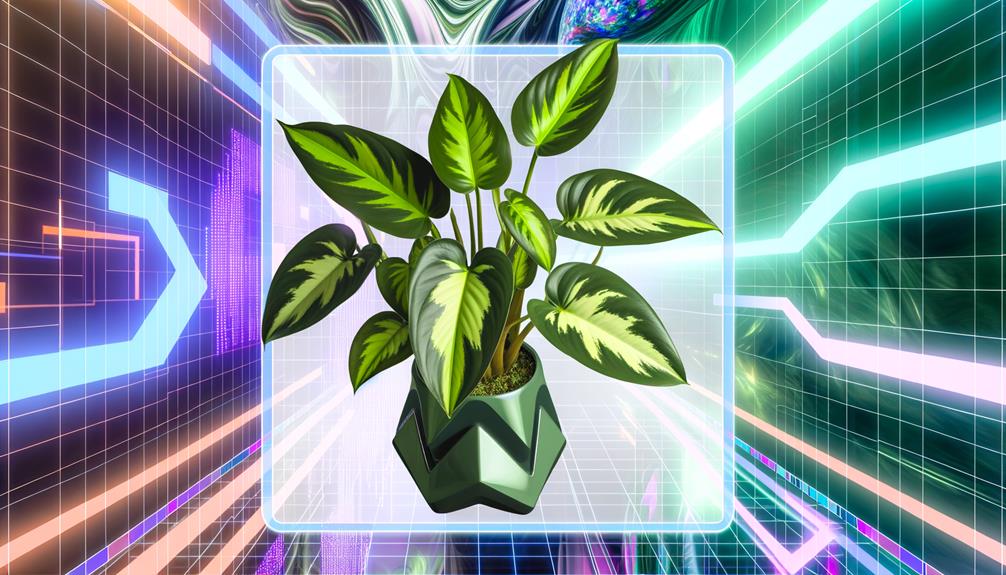
Emerging horticultural technologies and evolving consumer preferences are poised to shape the future trends of Philodendron Birkin cultivation and care. Advanced propagation techniques, such as tissue culture, will enhance genetic uniformity and disease resistance. Smart irrigation systems, featuring IoT integration, will optimize water usage, ensuring ideal growth conditions. Additionally, the shift towards sustainable practices will see increased use of organic substrates and eco-friendly pest control methods. Consumer demand for aesthetic and low-maintenance plants will drive innovations in hybridization, producing varieties with enhanced variegation and resilience.
| Technology | Impact | Trend |
|---|---|---|
| Tissue Culture | Genetic uniformity | Enhanced propagation |
| Smart Irrigation | Optimized water usage | IoT integration |
| Organic Substrates | Eco-friendly growth | Sustainable practices |
| Hybridization | Enhanced variegation | Aesthetic & resilient plants |
Conclusion
The Philodendron Birkin, with its striking, painterly variegation and luxuriant foliage, encapsulates a botanical marvel that intertwines nature's art with scientific intrigue. Its emergence in the horticultural world has sparked a surge of interest, transforming living spaces into verdant sanctuaries.
Understanding its botanical classification, meticulous care requirements, and the nuances of its popularity offers an insightful glimpse into this exquisite species. The Philodendron Birkin stands as a tribute to the profound beauty and complexity inherent in plant life.

